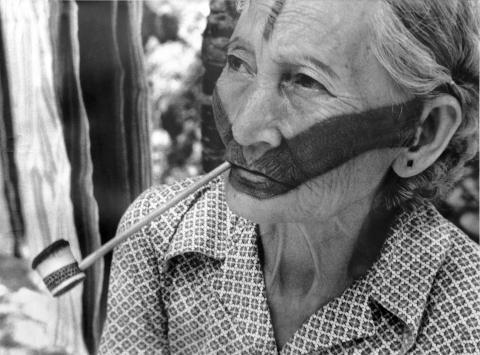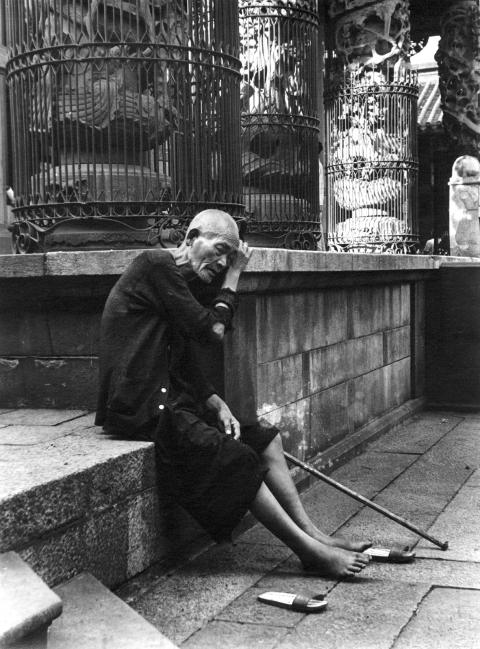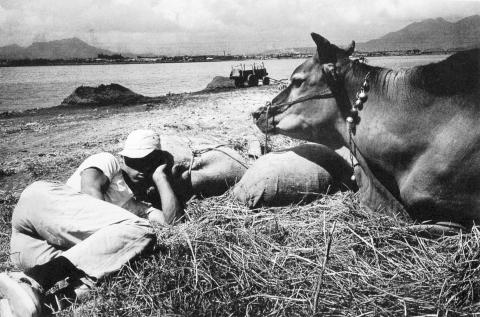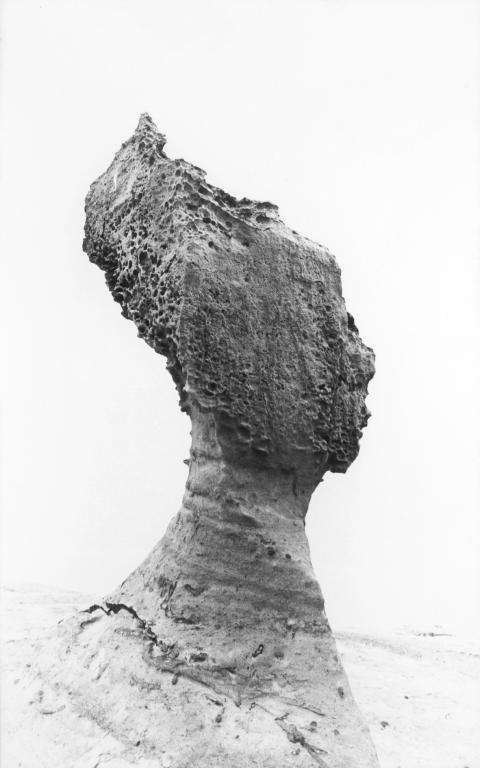Retrospective exhibits should offer an overview of an artist’s output, complete with the evolution of the styles and ideas underlying the trajectory of his or her work. Presumably, we are attracted to these kinds of exhibits because they show the path from unarticulated geniuses to masters in full control over their medium.
The Photographic Journey of a Maverick — Huang Tse-hsiu, 82 Years Young (臺灣攝影獨行俠:黃則修82影展) is a retrospective exhibit gargantuan in size and, for that reason, Lilliputian in its success.
Huang’s importance in Taiwan’s photographic history can be traced back to the 1950s with what art critic Chang Tsang-sang (張蒼松) has called the “nativist school” (鄉土派), a group of photographers that includes Deng Nan-guang (鄧南光), Lee Ming-tiao (李鳴鵰) and Chen Shih-an (陳石岸). Reacting to the staged and sentimental aesthetic of salon photography popular at the time (beautiful girls in scenic locations, for example), they felt that pictorial truth could only be achieved in the realism of ordinary subjects — landscapes and townscapes, Aboriginal people and folk culture.

Photo Courtesy of TFAM
Huang’s artistic reputation rests largely on two series first exhibited in the early 1960s: Lung Shan Temple (龍山寺) and Yaliu — Forsaken Paradise (尋不回的樂園 — 野柳). He’s also known as an innovator of color lithography for print media, though this has more to do with advertising and journalism than fine art photography.
For this, the Taipei Fine Arts Museum (TFAM) has given over its second floor space and allowed Huang to curate his own show, which includes about 350 images in 18 sections, as well as the cameras he used, detailed timelines, books and videos of interviews. To put this into perspective, Eye of the Times: Centennial Images of Taiwan (時代之眼 — 臺灣百年身影), a show held in the same space two months back, sought to encompass Taiwan’s entire photographic history with 271 photographs by 117 photographers. (None of Huang’s images were on display.) Clearly there is a problem of proportion; one has to question TFAM’s judgment in allowing a single photographer to take over its space.
With these caveats in mind, Photographic Journey of a Maverick still merits a viewing, if only for what Huang’s reputation as a gallery photographer is based on: Lung Shan Temple and Yaliu—Forsaken Paradise, the latter here renamed The Cape of Yaliu (野柳).

Photo Courtesy of TFAM
Mention of Lung Shan Temple, photographed between 1954 and 1959 and first exhibited in 1961, typically evokes one of two thematically related responses. The first imagines that the forlorn-looking men depicted in images with titles such as Silent Penitence (無言的懺悔), Unbearable Recollections (不堪回首) and Regret (悔不當初) troubled authorities who, soon after the images were exhibited, rounded the men up and removed them from the temple grounds. The second narrative states that the subjects were the patriarchs of wealthy local families, Huang’s lens capturing them in moments of deep contemplation, as though scholars from a bygone era.
Both stories, of course, are apocryphal. Suited to the social-historical ideas of the way in which contemporary observers view Taiwan’s recent history, the subjects are seen as either despondent victims of a military regime, or living manifestations of a great tradition dating back thousands of years.
What is most striking about Lung Shan Temple is that none of the old men are praying, lighting incense or making offerings — the kinds of ritual activities we might expect them to be engaged in. Rather, they sit silently looking at the ground or off into space. They don’t look as melancholy or contemplative as they do enervated and bored.

Photo Courtesy of TFAM
The women depicted in the same series, on the other hand, are the epitome of activity. They are praying at altars piled high with all manner of ritual offerings (ghost money, food, etc), and the composition’s dim lighting adds to the spiritual aura. In the absence of meaningful activity, the series seems to suggest, the men have come to the temple to pass away time.
With The Cape of Yaliu, Huang turns his lens to the bizarre hoodoo rock formations located in what is today known as Yehliu Geopark (野柳地質公園), on Taiwan’s north coast.
The jutting rocks and eroded shores of the region provide strong contrasts of light and shadow, lending these compositions an otherworldly feel that is underscored by titles such as The Forgotten Slipper of a Celestial Being (被遺忘的仙履), Guanyin With Black Face (黑面觀音) and Queen-Head Rock Formation (女王頭).

Photo Courtesy of TFAM
Huang also details rock patterns with a vocabulary drawn from the animal world — Wild Boar Outcropping (樂園山豬), Stone Eggs (小石卵), Guard Dog Formation (樂園的看門狗) — while the expressive textures of the surfaces evoke modern art (Picasso Portrait Rock Formation, 畢加索的人像畫).
Though the images collected in The Cape of Yaliu offer viewers a tableau of nature’s infinite variety, there doesn’t seem to be a strong narrative holding them together, except perhaps the imposition of known forms, whether drawn from nature or religion, and naming them detracts from their aesthetic appeal.
The other series brought together in The Photographic Journey of a Maverick offer an interesting glimpse of the changes Taiwan has experienced over the past five decades: the emergence of fashion and celebrity culture (Celebrities, 藝人); the cult of personality (Chiang Kai-shek Memorial Hall, 中正紀念堂); and the changing lifestyles of Taiwan’s autochthonous inhabitants (Traditional Lifestyles of Taiwan’s Aboriginal Peoples, 高山古情). At their best, they resemble reportage. At their worst, they appear similar to the sentimental photography Huang was rebelling against in the 1950s. In terms of artistic significance, Huang never really re-captured the resonant human subjects depicted in Lung Shan Temple.

Photo Courtesy of TFAM

The entire saga involving the Taiwan People’s Party (TPP) and its Chairman Ko Wen-je (柯文哲) continues to produce plot twists at such a rapid pace that fiction publishers would throw it out for being ridiculously improbable. This past week was particularly bizarre, but surprisingly the press has almost entirely ignored a big story that could have serious national security implications and instead focused on a series of salacious bombshell allegations. Ko is currently being held incommunicado by prosecutors while several criminal investigations are ongoing on allegations of bribery and stealing campaign funds. This last week for reasons unknown Ko completely shaved

Gabriel Gatehouse only got back from Florida a few minutes ago. His wheeled suitcase is still in the hallway of his London home. He was out there covering the US election for Channel 4 News and has had very little sleep, he says, but you’d never guess it from his twinkle-eyed sprightliness. His original plan was to try to get into Donald Trump’s election party at Mar-a-Lago, he tells me as he makes us each an espresso, but his contact told him to forget it; it was full, “and you don’t blag your way in when the guy’s survived two

The self-destructive protest vote in January that put the pro-People’s Republic of China (PRC) side in control of the legislature continues to be a gift that just keeps on giving to the Chinese Nationalist Party (KMT). Last week legislation was introduced by KMT Legislator Weng Hsiao-lin (翁曉玲) that would amend Article 9-3 of the Act Governing Relations Between the People of the Taiwan Area and the Mainland Area (臺灣地區與大陸地區人民關係條例) to permit retired and serving (!) military personnel to participate in “united front” (統戰) activities. Since the purpose of those activities is to promote annexation of Taiwan to the PRC, legislators

Nov. 18 to Nov. 24 Led by a headman named Dika, 16 indigenous Siraya from Sinkan Village, in what is today’s Tainan, traveled to Japan and met with the shogun in the summer of 1627. They reportedly offered sovereignty to the emperor. This greatly alarmed the Dutch, who were allies of the village. They had set up headquarters on land purchased from the Sinkan two years earlier and protected the community from aggressive actions by their more powerful rivals from Mattau Village. The Dutch East India Company (VOC) had been embroiled in a bitter trade dispute with Japan, and they believed